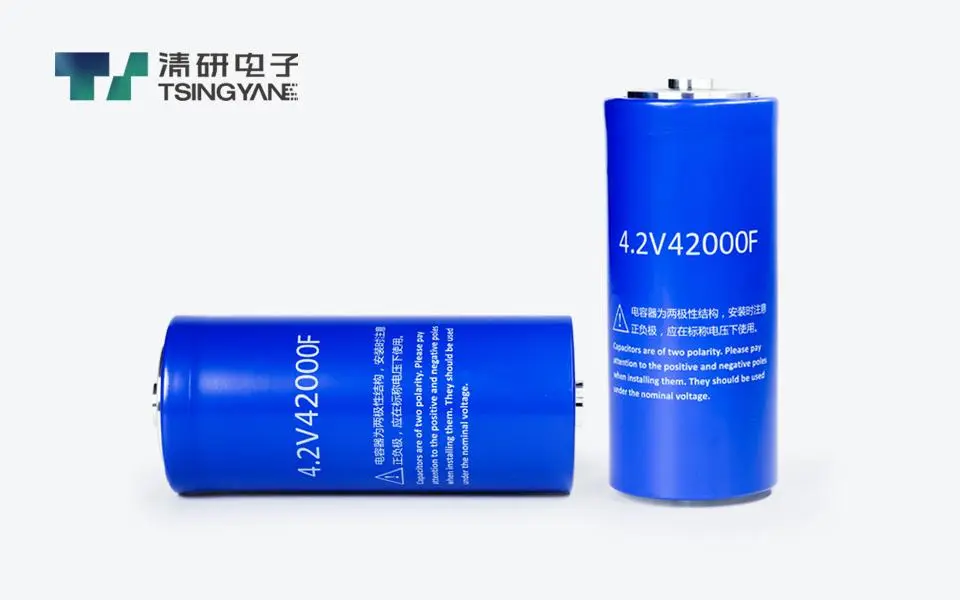Supercapacitors, also known as Farad capacitors. A supercapacitor is a new type of environmentally friendly energy storage device that lies between traditional capacitors and rechargeable batteries, with a capacity ranging from 0.1F to >10000F Farads. Compared to traditional capacitors, it has a larger capacity, higher energy, wider operating temperature range, and extremely long lifespan. Compared to batteries, it has higher power density and does not pollute the environment. Therefore, supercapacitors are an efficient, practical, and environmentally friendly energy storage device. Farad capacitors have a much larger capacity than typical capacitors. Due to their significant capacity, they exhibit similar characteristics to batteries, and thus they are sometimes called "capacitor batteries." Farad capacitors belong to the category of double-layer capacitors and are the largest-capacity double-layer capacitors mass-produced in the world. Their basic operating principle is the same as any other double-layer capacitors, utilizing a dual-layer structure composed of activated carbon porous electrodes and electrolytes to achieve enormous capacities.
Since their invention, supercapacitors have constantly been compared to traditional lithium batteries. Due to their significant advantages, such as the ability to be charged and discharged hundreds of thousands of times and their extremely long lifespan, it is conceivable that supercapacitors might gradually replace traditional lithium batteries in the future.

1. Working Principle
Supercapacitors and lithium batteries differ in their energy storage mechanisms; supercapacitors store energy through the double-layer storage mechanism, while lithium batteries store energy via chemical storage mechanisms.
2. Power Density and Energy Density
In terms of power density, supercapacitors can achieve over 7 kW/kg, whereas lithium batteries only reach about 1 kW/kg.
From the perspective of energy density, traditional lithium batteries have a wide range, from about 100 wh/kg to 300 wh/kg. In comparison, the energy density range of supercapacitors is much smaller.
3. Stored Electric Capacity
Supercapacitors use Farads (F) as their unit of capacity, generally ranging from 1F to 10000F.
Traditional lithium batteries use mAh as their capacity unit, usually ranging from 1 mAh to 100 Ah.
4. Charging/Discharging Time
Farad capacitors charge/discharge within milliseconds to seconds, while traditional lithium batteries take 1 to 10 hours to charge/discharge. Supercapacitors can be charged to any potential within their rated voltage range and fully discharged, whereas batteries operate within a much narrower voltage range due to their chemical reaction, risking permanent damage if over-discharged.
5. Operating Temperature Range
Farad capacitors can normally operate in a temperature range of -40°C to +85°C.
Traditional lithium batteries work in a range of -20°C to +60°C. Low temperatures can lead to damage when fully discharged.
6. Charging Methods
Farad capacitors charge by spanning a voltage across their terminals (similar to batteries).
Traditional lithium batteries require both current and voltage regulation.
7. Voltage Relationship in Operation
Farad capacitors typically operate between 2.3V to 3.0V per cell.
Traditional lithium batteries operate between 1.2V to 4.2V per cell.
8. Lifespan
Farad capacitors have a lifespan exceeding 1,000,000 cycles, while traditional lithium batteries last less than 1,000 cycles. Supercapacitors generally have much longer lifespans than lithium batteries, often surpassing ten years.
9. Environmental Impact
Supercapacitors do not pollute the environment during production, usage, or disassembly, making them an ideal eco-friendly energy source. In contrast, lithium batteries are not biodegradable and pose severe environmental pollution.
From the above differences and comparison between supercapacitors and traditional lithium batteries, we can see the advantages of supercapacitors. Not only now, but also in the future, they hold vast potential in industries such as automotive, IoT, and power tools.